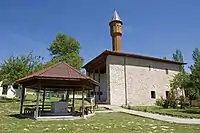

Mahmutbey Mosque (Turkish: Mahmut Bey Cami) is a historical mosque in Kasaba village in Kastamonu Province, Turkey.
Kasaba was once an important settlement in Kastamonu Province. Now, it is a small village about 18 km (11 mi) to Kastamonu. The 14th-century mosque of the village at 41°28′48″N 33°41′17″E / 41.48000°N 33.68806°E is an important cultural building of the province.
The mosque
It was commissioned by Mahmut Bey, a member of Candarid house in 1366. The mosque is unique in its building technique for no cement is used in the construction, except for the mihrab. The roof too was constructed without using any metal element. In fact, it is also known as Çivisiz camii meaning "mosque without nails".[1]The plan of the mosque is rectangular. It is one of the first wood columned and wood roofed mosques in Anatolia. The exterior of mosque was constructed by hewn stone. Ceiling of the building stands on four pillars. Inside the mosque, all the wood surfaces are decorated with vegetal paint colored ornaments.[2]The portal of the mosque, which was a masterpiece of art. It is now kept in the Kastamonu Ethnography Museum.[1] A replica of the original portal has been mounted in place.
World Heritage Site status
In 2023 the mosque was added to the list of UNESCO World Heritage Sites along with other medieval wooden hypostyle mosques in Afyon, Ankara, Beyşehir and Sivrihisar.[3]
Gallery
 Mahmut Bey Mosque in its garden
Mahmut Bey Mosque in its garden Kasaba Mahmut Bey Mosque entrance
Kasaba Mahmut Bey Mosque entrance Kasaba Mahmut Bey Mosque entrance door detail
Kasaba Mahmut Bey Mosque entrance door detail Kasaba Mahmut Bey Mosque entrance door detail
Kasaba Mahmut Bey Mosque entrance door detail Kasaba Mahmut Bey Mosque entrance door detail
Kasaba Mahmut Bey Mosque entrance door detail Kasaba Mahmut Bey Mosque view towards entrance
Kasaba Mahmut Bey Mosque view towards entrance Mahmut Bey Mosque Interior
Mahmut Bey Mosque Interior Kasaba Mahmut Bey Mosque Interior with balconies
Kasaba Mahmut Bey Mosque Interior with balconies Kasaba Mahmut Bey Mosque Interior with balconies
Kasaba Mahmut Bey Mosque Interior with balconies Kasaba Mahmut Bey Mosque Ceiling from te ground
Kasaba Mahmut Bey Mosque Ceiling from te ground Kasaba Mahmut Bey Mosque Interior painting detail
Kasaba Mahmut Bey Mosque Interior painting detail Kasaba Mahmut Bey Mosque Interior painting detail
Kasaba Mahmut Bey Mosque Interior painting detail Kasaba Mahmut Bey Mosque Interior painting detail
Kasaba Mahmut Bey Mosque Interior painting detail Kasaba Mahmut Bey Mosque Interior painting detail
Kasaba Mahmut Bey Mosque Interior painting detail Kasaba Mahmut Bey Mosque The minber
Kasaba Mahmut Bey Mosque The minber
References
- 1 2 Ministry of Culture page (in Turkish)
- ↑ Unesco page
- ↑ AA, Daily Sabah with (2023-09-20). "UNESCO adds Anatolia's wooden hypostyle mosques to World Heritage list". Daily Sabah. Retrieved 2024-01-09.


